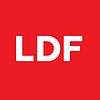Communist Party of India (Marxist)
The Communist Party of India (Marxist) (abbreviated CPI(M)) is a communist political party in India that adheres to Marxist–Leninist philosophy.[5][11] It is one of the national parties of India.[10] The party emerged from a split from the Communist Party of India in 1964. The CPI(M) was formed at the Seventh Congress of the Communist Party of India held in Calcutta from 31 October to 7 November 1964. As of 2018, CPI(M) is leading the state government in Kerala and has representation in the following Legislative assemblies in the states of Kerala, West Bengal, Tripura, Rajasthan, Himachal Pradesh, Odisha and Maharashtra.[12] As of 2018, CPI(M) claimed to have 1 million members.[13] The Politburo is the supreme organ of the Communist Party of India (Marxist).[14] However, in between two party congresses, the Central Committee is the highest decision making body.[14]
| Part of a series on |
| Communism in India |
|---|
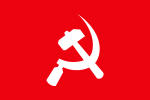 |
|
Personalities
|
|
Colonial Period and Partition
|
|
Cold War years
|
|
Other articles
|
|
|
| Part of a series on |
| Communist parties |
|---|
|
Africa
|
|
Americas
|
|
Asia
Former parties
|
|
Europe
Former parties
|
|
Oceania
Former parties
|
|
Related topics
|
|
Communist Party of India (Marxist) | |
|---|---|
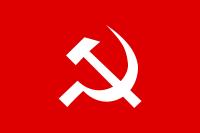 | |
| Abbreviation | CPI(M) |
| General Secretary | Sitaram Yechury |
| Lok Sabha leader | A. M. Ariff |
| Rajya Sabha leader | T. K. Rangarajan[1] |
| Founder |
|
| Founded | 7 November 1964 |
| Split from | Communist Party of India |
| Headquarters | A. K. Gopalan Bhawan, 27-29, Bhai Vir Singh Marg, New Delhi-110 001 |
| Newspaper | People's Democracy Ganashakti Deshabhimani Theekkathir |
| Student wing | Students' Federation of India |
| Youth wing | Democratic Youth Federation of India |
| Labour wing | Centre of Indian Trade Unions |
| Peasant's wing | All India Kisan Sabha |
| Membership | 1 million (2018)[4] |
| Ideology | Communism[5] Marxism–Leninism[5] Anti-capitalism[6] Anti-imperialism[6] |
| Political position | Left-wing[7][8] to far-left[9] |
| International affiliation | International Meeting of Communist and Workers' Parties |
| Colours | Red |
| ECI Status | National Party[10] |
| Alliance |
|
| Seats in Lok Sabha | 3 / 543
|
| Seats in Rajya Sabha | 5 / 245
|
| Seats in Vidhan Sabha & Vidhan Parishad | Indian states 1 / 68 (Himachal Pradesh Legislative Assembly)59 / 140 (Kerala Legislative Assembly)1 / 288 (Maharashtra Legislative Assembly)1 / 147 (Odisha Legislative Assembly)2 / 200 (Rajasthan Legislative Assembly)16 / 60 (Tripura Legislative Assembly)21 / 294 (West Bengal Legislative Assembly) |
| Number of states and union territories in government | 1 / 31
|
| Election symbol | |
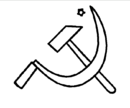 | |
| Website | |
| cpim | |
| |
History
Undivided Communist Party of India
Communist Party of India(Marxist) emerged from a division within the undivided Communist Party of India (CPI), which was formed on 17 October 1920. The undivided CPI had experienced a period of upsurge during the years following the Second World War. The CPI led armed rebellions in Telangana, Tripura, and Kerala. However, it soon abandoned the strategy of armed revolution in favour of working within the parliamentary framework. In 1950, B. T. Ranadive, the CPI general secretary and a prominent representative of the radical sector inside the party, was demoted on grounds of left-adventurism.
Under the government of the Indian National Congress party of Jawaharlal Nehru, independent India developed close relations and a strategic partnership with the Soviet Union. The Soviet government consequently wished that the Indian communists moderate their criticism towards the Indian state and assume a supportive role towards the Congress governments. However, large sections of the CPI claimed that India remained a semi-feudal country, and that class struggle could not be put on the back-burner for the sake of guarding the interests of Soviet trade and foreign policy. Moreover, the Indian National Congress appeared to be generally hostile towards political competition. In 1959 the central government intervened to impose President's Rule in Kerala, toppling the E.M.S. Namboodiripad cabinet (the sole non-Congress state government in the country).
Formation of CPI(M)
The relations between the Communist Party of the Soviet Union and the Communist Party of China soured, leading to the Sino-Soviet split around this time. In the early 1960s the Communist Party of China began criticising the CPSU of turning revisionist and of deviating from the path of Marxism–Leninism. Sino-Indian relations also deteriorated, as border disputes between the two countries erupted into the Sino-Indian War of 1962.
The basis of difference in opinion between the two factions in CPI was ideological – about the assessment of Indian scenario and the development of a party programme. This difference in opinion was also a reflection of a similar difference at international level on ideology between the Soviet and Chinese parties. The alleged 'right wing' inside the party followed the Soviet path and put forward the idea of joining hands with the then ruling party – Indian National Congress. Whereas the faction of CPI which later became CPI(M) referred to this as a revisionist approach of class collaboration. It was this ideological difference which later intensified, coupled with the Soviet-Chinese split at the international level and ultimately gave birth to CPI(M).[15]
Hundreds of CPI leaders, accused of being pro-Chinese, were imprisoned. Thousands of Communists were detained without trial.[16] Those targeted by the state accused the pro-Soviet leadership of the CPI of conspiring with the Congress government to ensure their own hegemony over the control of the party.
In 1962 Ajoy Ghosh, the general secretary of the CPI, died. After his death, S.A. Dange was installed as the party chairman (a new position) and E.M.S. Namboodiripad as general secretary. This was an attempt to achieve a compromise. Dange represented the rightist faction of the party and E.M.S. the leftist faction.
At a CPI National Council meeting held on 11 April 1964, 32 Council members walked out in protest, accusing Dange and his followers of "anti-unity and anti-Communist policies".[17]
The leftist section, to which the 32 National Council members belonged, organised a convention in Tenali, Andhra Pradesh 7 to 11 July. In this convention the issues of the internal disputes in the party were discussed. 146 delegates, claiming to represent 100,000 CPI members, took part in the proceedings. The convention decided to convene the 7th Party Congress of CPI in Calcutta later the same year.[18]
Marking a difference from the Dangeite sector of CPI, the Tenali convention was marked by the display of a large portrait of the Chinese Communist leader Mao Zedong.[18]
At the Tenali convention a Bengal-based pro-Chinese group, representing one of the most radical streams of the CPI left wing, presented a draft programme proposal of their own. These radicals criticised the draft programme proposal prepared by M. Basavapunniah for undermining class struggle and failing to take a clear pro-Chinese position in the ideological conflict between the CPSU and CPC.[19]
After the Tenali convention the CPI left wing organised party district and state conferences. In West Bengal, a few of these meetings became battlegrounds between the most radical elements and the more moderate leadership. At the Calcutta Party District Conference an alternative draft programme was presented to the leadership by Parimal Das Gupta (a leading figure amongst far-left intellectuals in the party). Another alternative proposal was brought forward to the Calcutta Party District Conference by Aziz ul Haq, but Haq was initially banned from presenting it by the conference organisers. At the Calcutta Party District Conference 42 delegates opposed M. Basavapunniah's official draft programme proposal.
At the Siliguri Party District Conference, the main draft proposal for a party programme was accepted, but with some additional points suggested by the far-left North Bengal cadre Charu Majumdar. However, Harekrishna Konar (representing the leadership of the CPI left wing) forbade the raising of the slogan Mao Tse-Tung Zindabad (Long live Mao Tse-Tung) at the conference.
Parimal Das Gupta's document was also presented to the leadership at the West Bengal State Conference of the CPI leftwing. Das Gupta and a few other spoke at the conference, demanding the party ought to adopt the class analysis of the Indian state of the 1951 CPI conference. His proposal was, however, voted down.[20]
The Calcutta Congress was held between 31 October and 7 November, at Tyagraja Hall in southern Calcutta. Simultaneously, the Dange group convened a Party Congress of CPI in Bombay. Thus, the CPI divided into two separate parties. The group which assembled in Calcutta would later adopt the name 'Communist Party of India (Marxist)', to differentiate themselves from the Dange group. The CPI(M) also adopted its own political programme. P. Sundarayya was elected general secretary of the party.
In total 422 delegates took part in the Calcutta Congress. CPI(M) claimed that they represented 104,421 CPI members, 60% of the total party membership.
At the Calcutta conference the party adopted a class analysis of the character of the Indian state, that claimed the Indian bourgeoisie was increasingly collaborating with imperialism.[21]
Parimal Das Gupta's alternative draft programme was not circulated at the Calcutta conference. However, Souren Basu, a delegate from the far-left stronghold Darjeeling, spoke at the conference asking why no portrait had been raised of Mao Tse-Tung along the portraits of other communist stalwarts. His intervention met with huge applauses from the delegates of the conference .[21]
Name
CPI(M) is officially known as भारत की कम्युनिस्ट पार्टी मार्क्सवादी(Bharat ki Kamyunist Party Marksvadi) in Hindi, but it is often known as मार्क्सवादी कम्युनिस्ट पार्टी (Marksvadi Kamyunist Party, abbreviated MaKaPa) in press and media circles. During its initial years after the split, the party was often referred by different names such as 'Left Communist Party' or 'Communist Party of India (Left)'. The party has used the name 'Left' because CPI people were dubbed as rightist in nature for their support to Congress-Nehru regime. During Kerala Legislative Assembly elections of 1965 the party has adopted the name 'Communist Party of India (Marxist)' to obtain its election symbol from the Election Commission of India.[22]
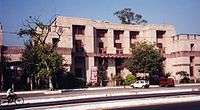
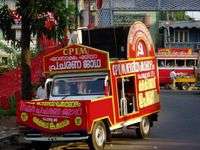
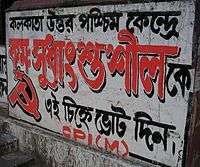

Early years of CPI(M)
The CPI (M) was born into a hostile political climate. At the time of the holding of its Calcutta Congress, large sections of its leaders and cadres were jailed without trial. Again on 29–30 December, over a thousand CPI (M) cadres were arrested and detained, and held in jail without trial. In 1965 new waves of arrests of CPI(M) cadres took place in West Bengal, as the party launched agitations against the rise in fares in the Calcutta Tramways and against the then prevailing food crisis. Statewide general strikes and hartals were observed on 5 August 1965, 10–11 March 1966 and 6 April 1966. The March 1966 general strike results in several deaths in confrontations with police forces.
Also in Kerala, mass arrests of CPI(M) cadres were carried out during 1965. In Bihar, the party called for a Bandh (general strike) in Patna on 9 August 1965 in protest against the Congress state government. During the strike, police resorted to violent actions against the organisers of the strike. The strike was followed by agitations in other parts of the state.
P. Sundaraiah, after being released from jail, spent the period of September 1965 – February 1966 in Moscow for medical treatment. In Moscow he also held talks with the CPSU.[23]
The Central Committee of CPI(M) held its first meeting on 12–19 June 1966. The reason for delaying the holding of a regular CC meeting was the fact that several of the persons elected as CC members at the Calcutta Congress were jailed at the time.[24] A CC meeting had been scheduled to have been held in Trichur during the last days of 1964, but had been cancelled due to the wave of arrests against the party. The meeting discussed tactics for electoral alliances, and concluded that the party should seek to form a broad electoral alliances with all non-reactionary opposition parties in West Bengal (i.e. all parties except Jan Sangh and Swatantra Party). This decision was strongly criticised by the Communist Party of China, the Party of Labour of Albania, the Communist Party of New Zealand and the radicals within the party itself. The line was changed at a National Council meeting in Jullunder in October 1966, where it was decided that the party should only form alliances with selected left parties.[25]
Naxalbari uprising
At this point the party stood at crossroads. There were radical sections of the party who were wary of the increasing parliamentary focus of the party leadership, especially after the electoral victories in West Bengal and Kerala. Developments in China also affected the situation inside the party. In West Bengal two separate internal dissident tendencies emerged, which both could be identified as supporting the Chinese line.[26]
In 1967 a peasant uprising broke out in Naxalbari, in northern West Bengal. The insurgency was led by hardline district-level CPI(M) leaders Charu Majumdar and Kanu Sanyal. The hardliners within CPI(M) saw the Naxalbari uprising as the spark that would ignite the Indian revolution. The Communist Party of China hailed the Naxalbari movement, causing an abrupt break in CPI(M)-CPC relations.[27]
The Naxalbari movement was violently repressed by the West Bengal government, of which CPI(M) was a major partner. Within the party, the hardliners rallied around an All India Coordination Committee of Communist Revolutionaries. Following the 1968 Burdwan plenum of CPI(M) (held on 5–12 April 1968), the AICCCR separated themselves from CPI(M). This split divided the party throughout the country. But notably in West Bengal, which was the centre of the violent radicalist stream, no prominent leading figure left the party. The party and the Naxalites (as the rebels were called) were soon to get into a bloody feud.
In Andhra Pradesh another revolt was taking place. There the pro-Naxalbari dissidents had not established any presence. But in the party organisation there were many veterans from the Telangana armed struggle, who rallied against the central party leadership. In Andhra Pradesh the radicals had a strong base even amongst the state-level leadership. The main leader of the radical tendency was T. Nagi Reddy, a member of the state legislative assembly. On 15 June 1968 the leaders of the radical tendency published a press statement outlining the critique of the development of CPI(M). It was signed by T. Nagi Reddy, D.V. Rao, Kolla Venkaiah and Chandra Pulla Reddy.[28]
In total around 50% of the party cadres in Andhra Pradesh left the party to form the Andhra Pradesh Coordination Committee of Communist Revolutionaries, under the leadership of T. Nagi Reddy.[29]
Dismissal of United Front governments in West Bengal and Kerala
In November 1967, the West Bengal United Front government was dismissed by the central government. Initially the Indian National Congress formed a minority government led by Prafulla Chandra Ghosh, but that cabinet did not last long. Following the proclamation that the United Front government had been dislodged, a 48-hour hartal was effective throughout the state. After the fall of the Ghosh cabinet, the state was put under President's Rule. CPI(M) launched agitations against the interventions of the central government in West Bengal.
The 8th Party Congress of CPI(M) was held in Cochin, Kerala, on 23–29 December 1968. On 25 December 1968, whilst the congress was held, 42 Dalits were burned alive in the Tamil village of Kizhavenmani. The massacre was a retaliation from landlords after Dalit labourers had taken part in a CPI(M)-led agitation for higher wages.[30][31]
The United Front government in Kerala was forced out of office in October 1969, as the CPI, RSP, KTP and Muslim League ministers resigned. E.M.S. Namboodiripad handed in his resignation on 24 October.[32] A coalition government led by CPI leader C. Achutha Menon was formed, with the outside support of the Indian National Congress.
Elections in West Bengal and Kerala
Fresh elections were held in West Bengal in 1969. CPI(M) contested 97 seats, and won 80. The party was now the largest in the West Bengal legislative.[33] But with the active support of CPI and the Bangla Congress, Ajoy Mukherjee was returned as Chief Minister of the state. Mukherjee resigned on 16 March 1970, after a pact had been reached between CPI, Bangla Congress and the Indian National Congress against CPI(M). CPI(M) strove to form a new government, instead but the central government put the state under President's Rule.
In Kerala, fresh elections were held in 1970. CPI(M) contested 73 seats and won 29. After the election Achutha Menon formed a new ministry, including ministers from the Indian National Congress.
Formation of CITU

Outbreak of war in East Pakistan
In 1971 Bangladesh (formerly East Pakistan) declared its independence from Pakistan. The Pakistani military tried to quell the uprising. India intervened militarily and gave active backing to the Bangladeshi rebels. Millions of Bangladeshi refugees sought shelter in India, especially in West Bengal.
At the time the radical sections of the Bangladeshi communist movement were divided into many factions. Whilst the pro-Soviet Communist Party of Bangladesh actively participated in the rebellion, the pro-China communist tendency found itself in a peculiar situation as China had sided with Pakistan in the war. In Calcutta, where many Bangladeshi leftists had sought refuge, CPI(M) worked to co-ordinate the efforts to create a new political organisation. In the fall of 1971 three small groups, which were all hosted by the CPI(M), came together to form the Bangladesh Communist Party (Leninist). The new party became the sister party of CPI(M) in Bangladesh.[34]
Political ideology and stances
The Party Constitution currently in force was adopted at the Eighth Party Congress in December 1968.[35]
Article II of the constitution lays out of the aim of the party:
"Revolutionary vanguard of the working class of India. Its aim is socialism and communism through the establishment of the state of dictatorship of the proletariat. In all its activities the Party is guided by the philosophy and principles of Marxism–Leninism which shows to the toiling masses the correct way to the ending of exploitation of man by man, their complete emancipation. The Party keeps high the banner of proletarian internationalism".
ARTICLE XXA of the constitution states that:
"The Communist Party of India (Marxist) shall bear true faith and allegiance to the Constitution of India as by law established and to the principles of socialism, secularism and democracy and would uphold the sovereignty, unity and integrity of India."
The party is well known for its anti-globalization and anti-capitalist stance.[6]
Controversy
It is claimed that CPI(M) cadres had also landed in Marichjhapi along with the state police, fired at, killed and raped islanders and looted their belongings during the Marichjhapi massacre of 1979.[36]
CPI(M) cadre, led by Nirupam Sen were accused in the Sainbari incident where many members of a family, among others, were brutalised and murdered for refusing to switch to supporting the CPI(M);[37] later on, he became a CPI(M) MLA and State Minister.[38][39] Documents of the case went missing from the high court.[38] Nirupam Sen has died in the meantime.
CPI(M) has been accused of the use of violence, including booth capturing and the abuse of state machinery.[40][41][42][43][44][45][46][47][48][49]
Party organisation
CPI(M) currently has three MPs in Lok Sabha. CPI(M)'s highest tally was in 2004 when it got 5.66% of votes polled in and it had 43 MPs. It won 42.31% on an average in the 69 seats it contested. It supported the new Indian National Congress-led United Progressive Alliance government, but without becoming a part of it. On 9 July 2008 it formally withdrew support from the UPA government explaining this by differences about the Indo-US nuclear deal and the IAEA Safeguards Agreement in particular.[50]
In West Bengal and Tripura it participates in the Left Front. In Kerala the party is part of the Left Democratic Front. In Tamil Nadu it was part of the ruling Democratic Progressive Alliance led by the Dravida Munnetra Kazhagam (DMK). However, it has since withdrawn support.
Its members in Great Britain are in the electoral front Unity for Peace and Socialism with the Communist Party of Britain and the British domiciled sections of the Communist Party of Bangladesh and the Communist Party of Greece (KKE). It is standing 13 candidates in the London-wide list section of the London Assembly elections in May 2008.[51]
Membership

Since the formation of the party, its membership has been increased from 118,683 in 1964 to 1,065,406 in 2013.[52]
In 2004, the party claimed a membership of 8,67,763.[53] Following is the list of statewise members of the party as in 2004.
| State | 2001 | 2002 | 2003 | 2004 | % of party members in electorate |
|---|---|---|---|---|---|
| Andhra Pradesh | 40785 | 41879 | 45516 | 46742 | 0.0914 |
| Assam | 10480 | 11207 | 11122 | 10901 | 0.0726 |
| Andaman and Nicobar Islands | 172 | 140 | 124 | 90 | 0.0372 |
| Bihar | 17672 | 17469 | 16924 | 17353 | 0.0343 |
| Chhattisgarh | 1211 | 1364 | 1079 | 1054 | 0.0077 |
| Delhi | 1162 | 1360 | 1417 | 1408 | 0.0161 |
| Goa | 172 | 35 | 40 | 67 | 0.0071 |
| Gujarat | 2799 | 3214 | 3383 | 3398 | 0.0101 |
| Haryana | 1357 | 1478 | 1477 | 1608 | 0.0131 |
| Himachal Pradesh | 1005 | 1006 | 1014 | 1024 | 0.0245 |
| Jammu and Kashmir | 625 | 720 | 830 | 850 | 0.0133 |
| Jharkhand | 2552 | 2819 | 3097 | 3292 | 0.0200 |
| Karnataka | 6574 | 7216 | 6893 | 6492 | 0.0168 |
| Kerala | 301562 | 313652 | 318969 | 316305 | 1.4973 |
| Madhya Pradesh | 2243 | 2862 | 2488 | 2320 | 0.0060 |
| Maharashtra | 8545 | 9080 | 9796 | 10256 | 0.0163 |
| Manipur | 340 | 330 | 270 | 300 | 0.0195 |
| Odisha | 3091 | 3425 | 3502 | 3658 | 0.0143 |
| Punjab | 14328 | 11000 | 11000 | 10050 | 0.0586 |
| Rajasthan | 2602 | 3200 | 3507 | 3120 | 0.0090 |
| Sikkim | 200 | 180 | 65 | 75 | 0.0266 |
| Tamil Nadu | 86868 | 90777 | 91709 | 94343 | 0.1970 |
| Tripura | 38737 | 41588 | 46277 | 51343 | 2.5954 |
| Uttarakhand | 700 | 720 | 740 | 829 | 0.0149 |
| Uttar Pradesh | 5169 | 5541 | 5477 | 5877 | 0.0053 |
| West Bengal | 245026 | 262882 | 258682 | 274921 | 0.579 |
| CC staff | 96 | 95 | 95 | 87 | |
| Total | 796073 | 835239 | 843896 | 867763 | 0.1292 |
Leadership
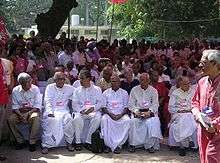
The current general secretary of CPI(M) is Sitaram Yechury. The 22nd party congress of CPI(M), held in Hyderabad 18 April 2018 elected a Central Committee with 95 members including 2 permanent invitees, 6 invitees and a five-member Central Control Commission. The Central Committee later elected a 17-member Politburo:[54]
Politburo members
| No. | Name | State |
|---|---|---|
| 1 | Sitaram Yechury (General Secretary) | West Bengal |
| 2 | Prakash Karat (Former General Secretary) | West Bengal |
| 3 | S. Ramachandran Pillai | Kerala |
| 4 | Manik Sarkar (Former Chief Minister of Tripura) | Tripura |
| 5 | Pinarayi Vijayan (Chief Minister of Kerala) | Kerala |
| 6 | Biman Bose | West Bengal |
| 7 | B. V. Raghavulu | Andhra Pradesh |
| 8 | Brinda Karat | West Bengal |
| 9 | Kodiyeri Balakrishnan | Kerala |
| 10 | Surja Kanta Mishra | West Bengal |
| 11 | M. A. Baby | Kerala |
| 12 | Mohammed Salim | West Bengal |
| 13 | Subhashini Ali | Uttar Pradesh |
| 14 | Hannan Mollah | West Bengal |
| 15 | G.Ramakrishnan | Tamil Nadu |
| 16 | Tapan Kumar Sen | West Bengal |
| 17 | Nilotpal Basu | West Bengal |
The 22nd party congress newly inducts Tapan Sen and Nilotpal Basu into the Politburo.[54]
Central Committee elected by the 22nd Party Congress
- Sitaram Yechury
- Prakash Karat
- S. Ramachandran Pillai
- Biman Bose
- Manik Sarkar
- Brinda Karat
- Pinarayi Vijayan
- Hannan Mollah
- Kodiyeri Balakrishnan
- M. A. Baby
- Surjya Kanta Mishra
- Mohammed Salim
- Subhashini Ali
- B. V. Raghavulu
- G. Ramakrishnan
- Tapan Kumar Sen
- Nilotpal Basu
- A. K. Padmanabhan
- Penumalli Madhu
- V. Srinivasa Rao
- M. A. Gafoor
- Deben Bhattacharyya
- Awadesh Kumar
- Arun Mehta
- Surender Mallik
- Onkar Shad
- Mohamad Yousuf Tarigami
- Gopi Kant Baksi
- G. V. Sreerama Reddy
- P. Karunakaran
- P.K. Sreemathi
- M.C. Josephine
- E.P. Jayarajan
- Vaikom Viswan
- T. M. Thomas Isaac
- A Vijayaraghavan
- K. K. Shailaja
- A K. Balan
- Elamaram Kareem
- Adam Narsayya Narayan
- Mahendra Singh
- Ali Kishore Patnaik
- Basu Deo
- Amra Ram
- T.K. Rangarajan
- U. Vasuki
- A Soundara Rajan
- K. Balakrishnan
- P. Sampath
- Thammineni Veerabhadram
- S. Veeraiah
- Ch. Seetha Ramulu
- Aghore Deb Barma
- Bijan Dhar
- Badal Choudhury
- Rama Das
- Gautam Das
- Hiralal Yadav
- Shyamal Chakraborty
- Mridul De
- Rekha Goswami
- Nripen Chowdhury
- Srideep Bhattacharya
- Ramachandra Dome
- Minoti Ghosh
- Anju Kar
- Hari Singh Kang
- Jogendra Sharma
- J. S. Majumdar
- K. Hemalata
- Sudha Sundararaman
- Rajendra Sharma
- Swadesh Dev Roye
- Ashok Dhawale
- S. Punyavati
- Suprakash Talukdar
- Arun Kumar Mishra
- K.M. Tiwari
- K. Radhakrishnan
- M.V. Govindan Master
- Jaswinder Singh
- J.P. Gavit
- G. Nagaiah
- Tapan Chakravarty
- Jiten Choudhury
- Muralidharan
- Arun Kumar
- Vijoo Krishnan
- Mariam Dhawale
- Rabin Deb
- Abhas Roy Choudhury
- Sujan Chakraborty
- Amiyo Patra
- Sukhwinder Singh Shekon
Special Invitees to Central Committee elected by the 22nd Party Congress
- V. S. Achuthanandan
- Mallu Swarajyam
- Madan Ghosh
- Paloli Mohammedkutty
- P. Ramaiah
- K. Varadharajan
Permanent Invitees to Central Committee elected by the 22nd Party Congress
- Rajinder Negi (Secretary, Uttarakhand state committee)
- Sanjay Parate (Secretary, Chhattisgarh state committee)
Central Control Commission elected by the 22nd Party Congress
- Basudev Acharia
- P. Rajendran
- S. Sridhar
- G. Ramulu
- Bonani Biswas
State Committee secretaries
- Andhra Pradesh: Penumalli Madhu
- Assam: Deben Bhattacharyya
- Bihar: Abdhesh Kumar
- Chhattisgarh: M.K. Nandi
- Goa: Thaelman Perera
- Gujarat: Pragajibhai Bhambhi
- Haryana: Inderjit Singh
- Himachal Pradesh: Rakesh Singha[55]
- Jammu & Kashmir : Mohammed Yousuf Tarigami
- Jharkhand: G.K. Bakshi
- Karnataka: G.V.Shree Ram Reddy
- Kerala : Kodiyeri Balakrishnan
- Madhya Pradesh: Badal Saroj
- Maharashtra: Narsayya Adam (Master)
- Manipur: Sarat Salam
- Odisha: Alikishore Patnaik
- Punjab: Charan Singh Virdi (Acting)
- Rajasthan: Vasudev Sharma
- Sikkim: Balram Adhikari
- Tamil Nadu: K. Balakrishnan
- Telangana: T. Veerbhadram
- Tripura: Bijan Dhar
- Uttarakhand: Vijai Rawat
- Uttar Pradesh: S.P. Kashyap
- West Bengal: Surjya Kanta Mishra[56]
- Andaman and Nicobar Islands: K.G. Das
- Chandigarh : NA
- Daman and Diu : NA
- Dadra and Nagar Haveli : NA
- Lakshadweep: Lukmanul Hakeem
- National Capital Territory of Delhi: P.M.S. Grewal
- Puducherry: R. Rajangam
General Secretaries of CPI(M)
Article XV, Section 15 of the party constitution says:
"No person can hold the position of the General Secretary for more than three full terms. Full term means the period between two Party Congresses. In a special situation, a person who has completed three full terms as General Secretary may be re-elected for a fourth term provided it is so decided by the Central Committee with a three-fourth majority. But in no case can that person be elected again for another term in addition to the fourth term."[57]
| No | Photo | Name | Tenure |
|---|---|---|---|
| 1st | P. Sundarayya | 1964–1978 | |
| 2nd |  | E.M.S. Namboodiripad | 1978–1992 |
| 3rd | Harkishan Singh Surjeet | 1992–2005 | |
| 4th | Prakash Karat | 2005–2015 | |
| 5th | Sitaram Yechury | 2015–Present |
Principal mass organisations of CPI(M)
- Democratic Youth Federation of India
- Students Federation of India
- Centre of Indian Trade Unions class organisation
- All India Kisan Sabha peasants' organisation
- All India Agricultural Workers Union
- Kerala Non Gazetted Officers Union
- All India Democratic Women's Association
- Bank Employees Federation of India
In Tripura, the Ganamukti Parishad is a major mass organisation amongst the tribal peoples of the state. In Kerala the Adivasi Kshema Samithi, a tribal organisation, is controlled by CPI(M).
State governments
As of 2020, the CPI(M) heads the state government in Kerala. Pinarayi Vijayan is Chief Minister of Kerala. The Left Front under CPI(M) ruled West Bengal for 34 years (1977–2011) and Tripura for 25 years (1993–2018)
Splits and offshoots
A large number of parties have been formed as a result of splits from the CPI(M), such as
- Communist Party of India (Marxist-Leninist),
- Marxist Communist Party of India,
- Marxist Coordination Committee in Jharkhand,
- Janathipathiya Samrakshana Samithy,
- Communist Marxist Party and BTR-EMS-AKG Janakeeya Vedi in Kerala,
- Party of Democratic Socialism in West Bengal,
- Janganotantrik Morcha in Tripura,
- the Ram Pasla group in Punjab,
- Odisha Communist Party in Odisha, etc.
- Communist Marxist Party (CMP) in Kerala.
- Revolutionary Marxist Party (RMP) in Kerala.
Elections
1967 general election
| Seats won | Seats contested | Seats total | Votes | % of total vote | |
|---|---|---|---|---|---|
| Lok Sabha: | 19 | 59 | 520 | 6246522 | 4.28% |
| Elections to State Legislative Assemblies: | |||||
| Andhra Pradesh | 9 | 83 | 287 | 1053855 | 7.61% |
| Assam | 0 | 14 | 126 | 61165 | 1.97% |
| Bihar | 4 | 32 | 318 | 173656 | 1.28% |
| Haryana | 0 | 8 | 81 | 16379 | 0.54% |
| Himachal Pradesh | 0 | 6 | 60 | 3019 | 0.39% |
| Kerala | 52 | 59 | 133 | 1476456 | 23.51% |
| Madhya Pradesh | 0 | 9 | 296 | 20728 | 0.23% |
| Maharashtra | 1 | 11 | 270 | 145083 | 1.08% |
| Manipur | 0 | 5 | 30 | 2093 | 0.67% |
| Mysore | 1 | 10 | 216 | 82531 | 1.10% |
| Orissa | 1 | 10 | 140 | 46597 | 1.16% |
| Punjab | 3 | 13 | 104 | 138857 | 3.26% |
| Rajasthan | 0 | 22 | 184 | 79826 | 1.18% |
| Tamil Nadu | 11 | 22 | 234 | 623114 | 4.07% |
| Tripura | 2 | 16 | 30 | 93739 | 21.61% |
| Uttar Pradesh | 1 | 57 | 425 | 272565 | 1.27% |
| West Bengal | 43 | 135 | 280 | 2293026 | 18.11% |
In the 1967 Lok Sabha elections, the CPI(M) nominated 59 candidates. In total 19 of them were elected. The party received 6.2 million votes (4.28% of the nationwide vote). By comparison, CPI won 23 seats and got 5.11% of the nationwide vote. In the state legislative elections held simultaneously, the CPI(M) emerged as a major party in Kerala and West Bengal. In Kerala a United Front government led by E.M.S. Namboodiripad was formed.[60] In West Bengal, the CPI(M) was the main force behind the United Front government formed. The Chief Ministership was given to Ajoy Mukherjee of the Bangla Congress (a regional splinter group of the Indian National Congress).
1971 general election
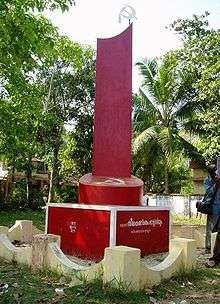
With the backdrop of the Bangladesh War and the emerging role of Indira Gandhi as a populist national leader, the 1971 election to the Lok Sabha was held. The CPI(M) contested 85 seats, and won in 25. In total the party mustered 7510089 votes (5.12% of the national vote). 20 of the seats came from West Bengal (including Somnath Chatterjee, elected from Burdwan), 2 from Kerala (including A.K. Gopalan, elected from Palakkad), 2 from Tripura (Biren Dutta and Dasarath Deb) and 1 from Andhra Pradesh.[61]
In the same year, state legislative elections were held in three states; West Bengal, Tamil Nadu and Odisha. In West Bengal CPI(M) had 241 candidates, winning 113 seats. In total the party mustered 4241557 votes (32.86% of the statewide vote). In Tamil Nadu CPI(M) contested 37 seats, but drew blank. The party got 259298 votes (1.65% of the statewide vote). In Odisha the party contested 11 seats, and won in two. The CPI(M) vote in the state was 52785 (1.2% of the statewide vote).[62]
1977 general elections
In the 1977 Lok Sabha elections, the CPI(M) had fielded its candidates on 53 seats scattred around in 14 states and union territories of India. It won 4.29% of the average votes polled in this election. The party had won 17 seats from West Bengal, 3 from Maharashtra and one each from Orrissa and Punjab. This election was done shortly after the Emergency imposed by the Indira Gandhi and reflected a wide uproar of masses against her draconian rule. A coalition of Opposition parties was formed against the Congress regime, CPI(M) too supported this coalition by not fielding its candidates against the Janta Party.[63]
1980 general elections
Janta Party coalition did not last much and two years after since its formation India had faced the 1980s Lok Sabha Elections. This election saw an increase in the vote percentage of CPI(M) and the party secured more seats then the previous elections. The Party had contested elections in the 15 states and union territories of India, and fielded its candidates on 64 seats. The party had won 37 seats in total. It won 28 seats in West Bengal, 7 in Kerala, and 2 seats in Tripura. The party emerged out as the whole sole representative of the people of Tripura in this election.[64]
2002 presidential elections
In the 2002 Presidential elections, Left Front announced Captain Lakshmi Sehgal as its presidential candidate. Against her was the ruling Bharatiya Janata Party's candidate A. P. J. Abdul Kalam.[65] CPI(M)'s Leadership has announced that in form of Captain Lakshmi, they are fielding an 'Alternative Candidate'. They said that though it is clear that Captain Lakshmi can't be the President of India because of the opposition of BJP led NDA and Indian National Congress to her, but through this Presidential Election Left wants to raise key national issues, and make them heard to the masses.[66] Captain Lakshmi herself had pointed out that this Presidential election reflects the opposition of the Indian Left to the Communal-Secreterian Politics of BJP and solidarity with the religious minorities who have suffered greatly under the National Democratic Alliance's leadership.[67]
2011 assembly elections
The CPI(M) led coalitions lost the assembly elections in Kerala and West Bengal. In Kerala, CPI(M) led Left Democratic Front coalition with 68 seats lost to Indian National Congress led United Democratic Front's 72 seats in a neck and neck fought assembly election. In West Bengal, CPI(M) alliance with 62 seats suffered a setback after 34 years of continuous rule, losing to Trinamool Congress alliance's 226 seats. Its Chief Minister candidate who was also the incumbent Chief Minister, Buddhadeb Bhattacharjee also lost from his Jadavpur assembly constituency.[68]
CPI(M) leader and former Chief Minister of Kerala, V.S. Achuthanandan has stated in a TV interview that Bengal defeat was "because of the deviation from party policies and because of its anti-peasant line. Though party tried to correct the mistakes, is not effective enough prevent the downturn." Former CPI(M) leader and prominent economist Ashok Mitra pointed out that the reason why Left Front got defeated in West Bengal is, among other things, the present state leaders deviated from communist policies and principles.[69] There is a criticism that Budhadeb Bhattacharya and Nirupam Sen (politician) were working as Corporate agents and was influenced by Neo-Liberal policies. CAG had earlier stated in its report that by allocating land to TATA at a subsidised rate, West Bengal govt incurred losses to the public exchequer. Former minister and CPI(M) leader Abdur Rezzak Mollah, blamed politburo members Buddhadeb Bhattacharjee and Nirupam Sen for the Left Front debacle in the Bengal assembly elections.[70] Wikileaks documents published in "The Hindu" newspaper revealed that Budhadeb had assured US Diplomats that if CPI(M) refused to approve neo-liberal policies the party would perish.[71] According to media reports Budhadeb rarely attended Politburo meeting.
2012 Vice-presidential election
.jpg)
While CPI(M) supported Pranab Mukherjee as presidential candidate in 2012 presidential election, it was in favour of a non-Congress candidate for the post of the Vice-President.[72]
2014 Lok Sabha election
Nine CPI(M) candidates were elected in the 2014 Indian general election, as well as two CPI(M)-supported independents. This is down from the previous number of 16. The national vote share of CPI(M) has also shrunk from 5.33% in 2009 to 3.28% in 2014. This is a 38.5% reduction within a span of 5 years which is consistent with the overall decline of the left in India.[73][74] CPI(M) did not win a single seat in Tamil Nadu and its seats went down from 9 to 2 in West Bengal where it is being heavily eroded by Mamata Banerjee governed AITMC. Kerala is the only state where CPI(M) gained one more seat but this is mainly attributed to splitting of anti-LDF votes between the UDF and emerging NDA. The NDA saw a sharp spike in vote share in decades which came coupled with a sharp decline in UDF votes. Thus, it is assumed that the NDA cut into UDF votes thereby facilitating victory for LDF. This was again mirrored during the 2016 Kerala Legislative Assembly election, which saw the NDA getting entry into the State Assembly for the first time as BJP veteran O. Rajagopal wins the Nemom seat and CPI(M)'s Pinarayi Vijayan forming the LDF-ruled government.
See also
- Bahadur Singh Dhakad
- Communist Party of India
- Communist Ghadar Party of India
- List of political parties in India
- Politics of India
- List of communist parties
- Election Results of Communist Party of India (Marxist)
- Co-ordinating Committee of Communist Parties in Britain
- List of communist parties in India
References
- "On P.R. Dasmunshi's Statement | Communist Party of India (Marxist)". Cpim.org. 13 November 2007. Archived from the original on 25 July 2011. Retrieved 20 December 2012.
- "The Founders of the CPI(M) Chronicle of Nine Inspiring Lives". People's Democracy. Retrieved 4 April 2019.
- "Nine to none, founders' era ends in CPM". The Telegraph. Retrieved 4 April 2019.
- "Abou us". Official Website -CPI(M). 18 March 2009.
- "Party Constitution of Communist Party of India (Marxist)". cpim.org. 2018. Retrieved 28 December 2018.
- Archived 1 December 2017 at the Wayback Machine Marxism in the 21st Century: Alternative to Neoliberal Capitalism and Imperialism, The Marxist, XXVII 4, October–December 2011. Accessed online 23 November 2017.
- "Manipur: CPI State Secretary, Blogger Arrested over CAA Protests". The Wire. Retrieved 24 December 2019.
- "India's election results were more than a 'Modi wave'". Washington Post. Retrieved 31 May 2019.
- Parmar, Tekendra (20 May 2019). "Meet India's Most Prominent Democratic Socialist". The Nation. Retrieved 20 May 2019.
- "List of Political Parties and Election Symbols main Notification Dated 18.01.2013". India: Election Commission of India. 2013. Retrieved 9 May 2013.
- Chakrabarty, Bidyut (2014). Communism in India: Events, Processes and Ideologies. Oxford University Press. p. 314. ISBN 978-0-199-97489-4.
- "RAJASTHAN ELECTION RESULTS 2018". 28 November 2014. Retrieved 12 December 2018.
- "About Communism Party of India (Marxist)". Archived from the original on 28 November 2014. Retrieved 14 November 2014.
- "Party Constitution | Communist Party of India (Marxist)". 18 March 2009. Archived from the original on 17 March 2020. Retrieved 17 March 2020.
- "Communist Party in Kerala". CPI(M). Archived from the original on 14 March 2012.
- The bulk of the detainees came from the left wing of the CPI. However, cadres of the Socialist Unity Centre of India and the Workers Party of India were also targeted. Archived 17 October 2007 at the Wayback Machine
- The 32 were P. Sundarayya, M. Basavapunniah, T. Nagi Reddy, M. Hanumantha Rao, D.V. Rao, N. Prasad Rao, G. Bapanayya, E.M.S. Namboodiripad, A.K. Gopalan, A.V. Kunhambu, C.H. Kanaran, E.K. Nayanar, V.S. Achuthanandan Removed, E.K. Imbichibava, Promode Das Gupta, Muzaffar Ahmad, Jyoti Basu, Abdul Halim, Hare Krishna Konar, Saroj Mukherjee, P. Ramamurthi, M.R. Venkataraman, N. Sankariah, K. Ramani, Harkishan Singh Surjeet, Jagjit Singh Lyallpuri, D.S. Tapiala, Bhag Singh, Sheo Kumar Mishra, R.N. Upadhyaya, Mohan Punamiya and R.P. Saraf. Source: Bose, Shanti Shekar; A Brief Note on the Contents of Documents of the Communist Movement in India. Kolkata: 2005, National Book Agency, p. 37.
- Basu, Pradip. Towards Naxalbari (1953–1967) – An Account of Inner-Party Ideological Struggle. Calcutta: Progressive Publishers, 2000. p. 51.
- Suniti Kumar Ghosh was a member of the group that presented this alternative draft proposal. His grouping was one of several left tendencies in the Bengali party branch. Basu, Pradip. Towards Naxalbari (1953–1967) – An Account of Inner-Party Ideological Struggle. Calcutta: Progressive Publishers, 2000. p. 32.
- Basu, Pradip. Towards Naxalbari (1953–1967) – An Account of Inner-Party Ideological Struggle. Calcutta: Progressive Publishers, 2000. p. 52-54.
- Basu, Pradip. Towards Naxalbari (1953–1967) – An Account of Inner-Party Ideological Struggle. Calcutta: Progressive Publishers, 2000. p. 54.
- Basu, Jyoti. Memoirs – A Political Autobiography. Calcutta: National Book Agency, 1999. p. 189.
- M.V.S. Koteswara Rao. Communist Parties and United Front – Experience in Kerala and West Bengal. [Hyderabad, India]: Prajasakti Book House, 2003. p. 17-18
- The jailed members of the new CC, at the time of the Calcutta Congress, were B.T. Ranadive, Muzaffar Ahmed, Hare Krishna Konar and Promode Das Gupta. Source: Bose, Shanti Shekar; A Brief Note on the Contents of Documents of the Communist Movement in India. Kolkata: 2005, National Book Agency, p. 44-5.
- M.V.S. Koteswara Rao. Communist Parties and United Front – Experience in Kerala and West Bengal.[Hyderabad, India]: Prajasakti Book House, 2003. p. 234-235.
- According to Basu (in Basu, Pradip; Towards Naxalbari (1953–67) : An Account of Inner-Party Ideological Struggle. Calcutta: Progressive Publishers, 2000.) there were two nuclei of radicals in the party organisation in West Bengal. One "theorist" section around Parimal Das Gupta in Calcutta, which wanted to persuade the party leadership to correct revisionist mistakes through inner-party debate, and one "actionist" section led by Charu Majumdar and Kanu Sanyal in North Bengal. The 'actionists' were impatient, and strived to organize armed uprisings. According to Basu, due to the prevailing political climate of youth and student rebellion it was the 'actionists' which came to dominate the new Maoist movement in India, instead of the more theoretically advanced sections. This dichotomy is however rebuffed by followers of the radical stream, for example the CPI(ML) Liberation Archived 27 September 2007 at the Wayback Machine.
- On 1 July People's Daily carried an article titled Spring Thunder Over India Archived 23 February 2007 at the Wayback Machine, expressing the support of CPC to the Naxalbari rebels. At its meeting in Madurai on 18–27 August 1967, the Central Committee of CPI(M) adopted a resolution titled 'Resolution on Divergent Views Between Our Party and the Communist Party of China on Certain Fundamental Issues of Programme and Policy'. Source: Bose, Shanti Shekar; A Brief Note on the Contents of Documents of the Communist Movement in India. Kolkata: 2005, National Book Agency, p. 46.
- This press statement was reproduced in full in the central CPI(M) publication, People's Democracy, on 30 June. P. Sundarayya and M. Basavapunniah, acting on behalf of the Polit Bureau of CPI(M), formulated a response to the statement on 16 June, titled 'Rebuff the Rebels, Uphold Party Unity'. Source: Bose, Shanti Shekar; A Brief Note on the Contents of Documents of the Communist Movement in India. Kolkata: 2005, National Book Agency, p. 48.
- Some perceive that the Chinese leadership severely misjudged the actual conditions of different Indian factions at the time, giving their full support to the Majumdar-Sanyal group whilst keeping the Andhra Pradesh radicals (that had a considerable mass following) at distance.
- Dalits and land issues Archived 23 February 2008 at the Wayback Machine
- "Untitled-1" (PDF). Archived from the original (PDF) on 4 March 2016. Retrieved 27 July 2015.
- officialwebsite of kerala.gov.inArchived 5 August 2006 at the Wayback Machine
- Indian National Congress had won 55 seats, Bangla Congress 33 and CPI 30. CPI(M) allies also won several seats.ECI: Statistical Report on the 1969 West Bengal Legislative Election Archived 29 November 2007 at the Wayback Machine
- The same is also true for the Workers Party of Bangladesh, which was formed in 1980 when BCP(L) merged with other groups. Although politically close, WPB can be said to have a more Maoist-oriented profile than CPI(M).
- Archived 15 March 2015 at the Wayback Machine Amended April 2015 at the 21st Party Congress, Kozhikode, India. Accessed online 22 November 2017.
- "The Left massacre of migrant Hindus in Bengal that was bigger than 2002 & 1984". 11 May 2019.
- "Almost 50 years ago, this day, a mother was fed rice smeared with her sons' blood – Sainbari Killings".
- "Victims recall Sainbari horror | Kolkata News - Times of India".
- "Irony deals a brutal hand on this family — in CPM-Congress alliance, 46 yrs after Sainbai massacre". 9 April 2016.
- Limaye, Madhu (1988). Birth of Non-Congressism: Opposition Politics, 1947-1975. Delhi: B.R. Publishing Corporation. p. 353. ISBN 8170184800.
- "How to rig elections, Bengal style".
- "Is mastery of booth-capturing technique the secret of CPI(M)'s continuance in power?".
- India Today, Volume 31, Issues 1-12, p. 32, at Google Books
- "Bogus Voting in Kannur: The Left on the Backfoot". 29 April 2019.
- "Bogus voting in Kerala's Kannur? Videos of people casting vote twice surface". 28 April 2019.
- The Indian Journal of Public Administration, Volume 37, p. 483, at Google Books
- "EVM Hack: Play politics, certainly. But don't play with the idea of our democracy".
- "The goons of West Bengal: Violence, guns, and murder during elections". 23 April 2016.
- Sagarika Ghose on Twitter: ""Booth capturing" now reported from parts of Gujarat. Thought this innovative form of "scientific rigging" went out with the CPM in 2011..clearly n...
- article in The Hindu, 9 July 2008: Left meets President, hands over letter of withdrawal Archived 13 July 2008 at the Wayback Machine
- Unity For Peace and Socialism homepage
- "CPIM : About Us". CPIM. 5 January 2015. Archived from the original on 10 July 2015. Retrieved 12 June 2015.
- Membership figures from "2005 CPIM membership". 3 April 2005. Archived from the original on 24 February 2008. Electorate numbers taken from Election Commission. Puducherry is counted as part of Tamil Nadu, Chandigarh counted as part of Punjab.
- "New Central Committee Elected at the 22nd Congress". 22 April 2018. Archived from the original on 27 May 2018. Retrieved 27 May 2018.
- List of State Secretaries Archived 12 February 2010 at the Wayback Machine
- BS Reporter (13 March 2015). "Surya Kanta Mishra replaces Biman Bose as CPI(M) Bengal unit secretary". Business Standard India. Archived from the original on 3 July 2015. Retrieved 27 July 2015.
- CPI(M) Constitution Archived 15 March 2015 at the Wayback Machine.
- "Members of PB – 7th to 19th Congress | Communist Party of India (Marxist)". Cpim.org. Archived from the original on 25 November 2012. Retrieved 20 December 2012.
- "CPI (M) Website". Archived from the original on 24 November 2012. Retrieved 9 October 2012.
- In Kerala the United Front consisted, at the time of the election, of Communist Party of India (Marxist), the Communist Party of India, the Muslim League, the Revolutionary Socialist Party, the Karshaka Thozhilali Party and the Kerala Socialist Party."Archived copy". Archived from the original on 5 August 2006. Retrieved 26 July 2006.CS1 maint: archived copy as title (link)
- ECI: Statistical Report on the 1971 Lok Sabha Election Archived 16 June 2007 at the Wayback Machine
- ECI: Statistical Report on the 1971 Orissa Legislative Election Archived 16 June 2007 at the Wayback Machine, ECI: Statistical Report on the 1971 Tamil Nadu Legislative Election Archived 16 June 2007 at the Wayback Machine, ECI: Statistical Report on the 1971 West Bengal Legislative Election Archived 16 June 2007 at the Wayback Machine
- "1977 general elections ECI Report" (PDF). Archived from the original (PDF) on 18 July 2014. Retrieved 27 July 2015.
- "1980 General Elections ECI Report" (PDF). Archived from the original (PDF) on 18 July 2014. Retrieved 27 July 2015.
- "Left parties to field Lakshmi Sahgal". The Hindu. New Delhi. 15 June 2002. Archived from the original on 9 November 2012. Retrieved 29 June 2012.
- "question & answer on the election". cpim.org. Archived from the original on 6 April 2013. Retrieved 11 September 2018.
- "interview with lakshmi sahgal". cpim.org. Archived from the original on 25 July 2011. Retrieved 14 January 2011.
- "Live Election Results, Delhi Elections 2015, Assembly Election Live News". www.ndtv.com. Archived from the original on 21 November 2011. Retrieved 27 July 2015.
- "With No Apologies". The Telegraph. Calcutta, India. 20 May 2011. Archived from the original on 23 May 2011. Retrieved 4 June 2011.
- "CPM censures former land minister". The Times of India. Archived from the original on 21 November 2011. Retrieved 4 June 2011.
- Hiddleston, Sarah (3 April 2011). "West Bengal's pro-business Chief Minister reaches out". The Hindu. Chennai, India. Archived from the original on 25 October 2012. Retrieved 4 June 2011.
- "CPI(M) favours non-Congress candidate for VP post: Prakash Karat". 12 July 2012. Archived from the original on 17 March 2013. Retrieved 12 July 2012.
- Archive of GE 2009 - Performance of National Parties (PDF), 1, Election Commission of India, 2009, archived (PDF) from the original on 9 December 2017, retrieved 16 November 2017
- Archive of GE 2014 - Performance of National Parties (PDF), Election Commission of India, 2014, archived (PDF) from the original on 15 December 2017, retrieved 16 November 2017
- Not only all candidates contesting from West Bengal lost election, one but all lost their security deposits also.
External links
| Wikimedia Commons has media related to Communist Party of India (Marxist). |
